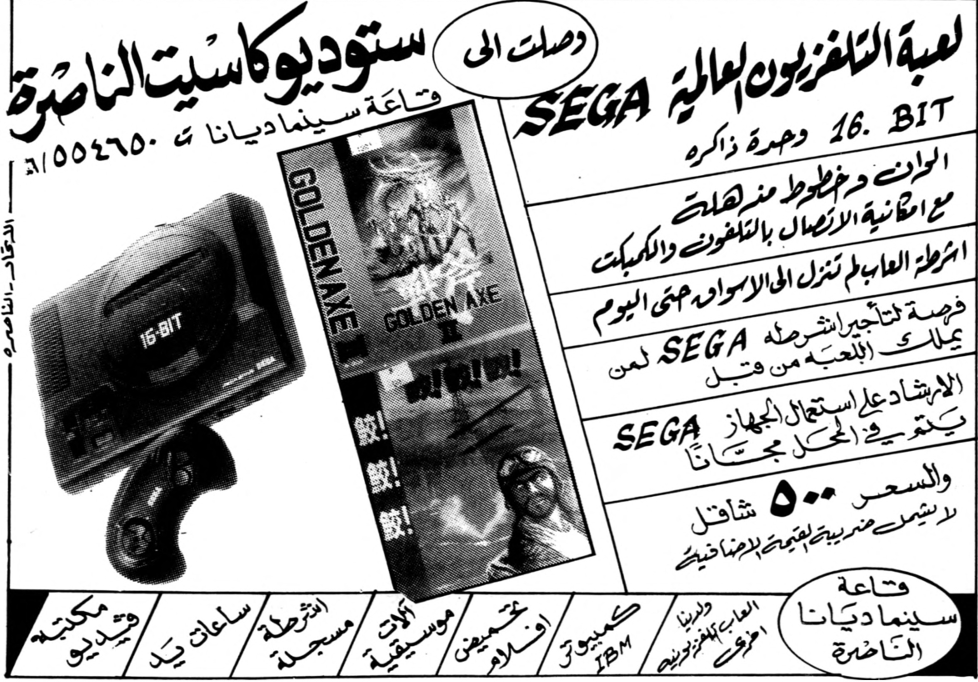History of Sega in Israel
From Sega Retro

|
| History of Sega in Israel |
|---|
| Official Sega distributor(s): Bug Multisystem (1987-1993), Suny Electronics (1993-1998), Hed Arzi (200x-present) |
This short article is in need of work. You can help Sega Retro by adding to it.
Contents
Bug Multisystem
During his stay in New York, Moshe Raviv stumbled upon the Sega exhibition where he saw their games. Later, at a gaming show in the US, he met with Sega's Japan executives and told them that he is interested in distributing the Master System in Israel. It took him a long time to convince the Japanese to grant him a license to import consoles into the country. In 1987, Bug Multisystem began distributing the Sega Master System in Israel. Moshe Raviv amazed Sega of Japan and himself when he quickly sold 5,000 units of Master System in Israel. Every customer bought a few games (mostly five) immediately with console. Until February 1988, Bug already had 9 branches in the country where they sold consoles and had its own fan club. On Purim, it was planned to organize a national competition, the winner of which was a representative in world competition organized by Sega in Europe.[1]
Bug promoted the products with the slogan הערוץ הרביעי בטלויזיה שלך[2]. Additionally, in late 1980s, a gaming magazine called Sega-Tron began to be published. Master System competed with Nintendo Entertainment System, distributed from late 1980s by 2 authorized distributors. The 8-bit Sega system has been well received in country and was so good that the next Sega consoles weren't released until 1992, when Mega Drive, Game Gear and Master System II, finally went to sell in Israel. All systems were in the European PAL system. On June 8, 1992, two companies established Sega - Bug (Israel) Ltd.[3] in order to better coordinate activities in the country. However, further cooperation did not last long, because right in 1993 Bug decided to focus on the promotion and distribution of Sega competitors - Super Nintendo and Game Boy, eventually focusing on PC market.
Suny Electronics - STV Sega Israel
During this time, Sega became the object of interest to businessman Ilan Ben-Dov, who imported Sega consoles since about 1987. In 1991, he founded Suny Electronics, and from May 1991 he was a franchisee of Sega, Nintendo and Famiclones. From 1993, he re-established Sega - Bug (Israel) Ltd. with a new company called STV Sega Israel and from now on, consoles and games were released very closely to the European premiere with every system being same as in Europe. The same year, Suny started active promotion of Sega products, including the newly released Mega Drive II and Mega CD II. Advertisements for the Palestine region were translated into Arabic.
The new distributor had to deal with a wave of Sega Genesis imports and Mega Drive clones resembling the first Japanese model. The advertisements informed about the differences between the originals and to watch out for bootleg copies of the games. A black seal with a yellow Sega logo and yellow Hebrew inscriptions was placed on each original console. The game boxes, on the other hand, had a white sticker with Hebrew inscriptions. In the following years, the Sega Multi-Mega, Mega Drive 32X and Sega Saturn were released. Mega Drive, like the Master System, was well received in Israel and was a popular console in that country. Besides Famicom and Mega Drive clones, Sega had competition mostly in form of official Nintendo consoles (distributed by Bug), but in some larger retailers 3DO, Amiga CD32, Atari Jaguar and Neo Geo could be found. From March 1997, PlayStation (distributed by Isfar[4]) became the biggest competitor for Saturn.
In 1996, Sega Enterprises Israel was created. The company was involved in importing arcades to Israel.[5] From 2007, the name was changed to Astela Asets & Investments Ltd[6].
In January 1996, TCI's technology group got the rights to distribute Sega Channel in Israel, but it isn't known that the service was launched there.[7]
In February 1998, Suny withdrew from selling video games and began distributing Samsung cell phones. In the same year, importers began to sell Sega Nomad.
Dreamcast and Hed Arzi
Sega Dreamcast was also released in Israel and was seen in bigger video games retailers outlets.
Sega games from Xplosiv series were releasd in early 2000s as Xtreme series by Hed Arzi, [8]which from similar period began to work with Sega and became representative for Israel and continue it until this day[9]. Red Vault from Red Entertainment Distribution (Sega distributor in the MENA) was available in Palestine region[10].
External links
- https://datacheck.co.il/company.asp?ID=511691396
- https://www.globes.co.il/news/article.aspx?did=138575
References
- ↑ https://www.nli.org.il/he/newspapers/hadashot/1988/02/23/01/article/180/?e=-------he-20--1--img-txIN%7ctxTI--------------1
- ↑ https://www.nli.org.il/he/newspapers/mar/1987/11/30/01/article/264/?srpos=230&e=------198-he-20--221-byDA-img-txIN%7ctxTI-%d7%a1%d7%92%d7%94+-------------1
- ↑ https://serviced.co.il/company-details/511691396/
- ↑ http://web.archive.org/web/19980703064424/http://www.playstation-europe.com/playstation/pr/launch.htm
- ↑ https://web.archive.org/web/20070329172741/http://www.sega.co.il/
- ↑ https://www.dunsguide.co.il/en/Cc6e3d498680c67aaf2c18a4c97f13a6a_game_machines/sega_enterprises_israel_1996/
- ↑ https://forums.sonicretro.org/index.php?threads/more-sega-channel-prototypes-dumped.25935/page-11#post-833889
- ↑ https://oldschool.org.il/videos/%D7%94%D7%9E%D7%A7%D7%A8%D7%94-%D7%94%D7%9E%D7%95%D7%96%D7%A8-%D7%A9%D7%9C-%D7%9E%D7%A9%D7%97%D7%A7%D7%99-%D7%90%D7%A7%D7%A1%D7%98%D7%A8%D7%99%D7%9D/
- ↑ https://web.archive.org/web/20091224011006/http://www.sega.com/support/
- ↑ https://web.archive.org/web/20180522062924/http://redvault.co/ar/






